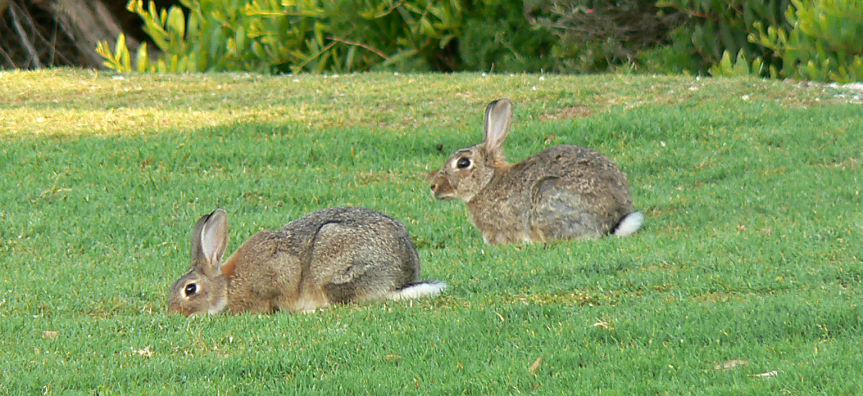
Rabbits on the Northern Beaches
Domesticated rabbits arrived in Australia with the First Fleet. The first wild population began in Victoria in 1859 when rabbits were released for hunting. Wild rabbits are now abundant across Australia and are well established on the Northern Beaches. Council undertakes control programs, but you can also help.
The wild rabbit population on the Northern Beaches is influenced by accidental or deliberate release of domestic rabbits. Domestic and wild rabbits readily interbreed. It’s cruel and irresponsible to release your pet into the wild. Contact a pet rescue service if you’re unable to care for your rabbit.
The release of non-native animals without a license (apart from homing pigeons) is prohibited under the National Parks and Wildlife Act 1974. Abandoning animals is prohibited under the Prevention of Cruelty to Animals Act 1979, with a maximum penalty of $5500 or six months jail.
Where are you likely to see wild rabbits?
Wild rabbits are found in all kinds of habitats from bushland reserves and urban boundaries, golf courses, sportsfields and private properties where they can destroy vegetation and graze on open lawn.
Priority Pests
Wild rabbits are a Priority pest and are responsible for major environmental damage to native vegetation, sportsfields, reserves, lawns and gardens. According to the NSW Government, wild rabbits cost Australia more than $200 million in damage each year.
Why are rabbits a problem?
Rabbits are a problem because they destroy native vegetation, increase erosion and damage lawns, gardens and sportsfields. They eat the seedlings of native and garden plants, reducing native plant biodiversity and competing with native animals for food and shelter.
Rabbit control programs
Australia has been engaged in wild rabbit control programs since the 1920s. The control of feral animal populations in urban areas is most effective when carried out in a coordinated manner. Control programs used by Council include the annual release of Rabbit Haemorrhagic Disease (RHDV1), shooting, warren fumigation and other control methods.
What can you do?
If you have wild rabbits on your property, please take steps to control them. There are two ways to do this - contact a qualified pest controller or find out about the rabbit trapping procedure and trap hire program by emailing Council.
Keeping wild rabbits off your property
There are three simple steps you can take to keep wild rabbits off your property:
- Fence the property to prevent access
- Place blood and bone around the property boundary to deter rabbits
- Spray plants with a liquid deterrent made from boiled garlic and chilli and reapply after rain
Sydney North Vertebrate Pest Committee
Sydney North Vertebrate Pest Committee was established in 1998. The group consists of key land managers from across the Sydney North Region including local government, NSW National Parks and Wildlife Service, Local Land Services, Forestry NSW, Sydney Water, Taronga Zoo and Sydney Harbour Federation Trust. The aim of the group is to share information, raise awareness, educate the community and develop the skills required to manage feral animals including rabbits.
Rabbits and the law
Land owners are required to “fully and continuously suppress and destroy" wild rabbits on their land under the NSW Biosecurity Act 2015. Competition and land degradation by wild rabbits is a key threat to endangered Australian native animals and ecological communities under the Commonwealth Environment Protection and Biodiversity Conservation Act 1999.
Own a pet rabbit?
You need to think carefully before owning a pet rabbit. Be responsible and de-sex your rabbit. Vaccinate your rabbit annually for Rabbit Haemorrhagic Disease. Keep your rabbit in a secure hutch as they can escape easily. If you can no longer keep your rabbit, find new owners or take it to the RSPCA.
